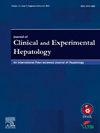探讨治疗性血浆交换对ACLF患者器官功能的影响:一项回顾性、单中心倾向评分匹配的队列研究
IF 3.2
Q2 GASTROENTEROLOGY & HEPATOLOGY
Journal of Clinical and Experimental Hepatology
Pub Date : 2025-03-24
DOI:10.1016/j.jceh.2025.102550
引用次数: 0
摘要
背景和目的急性慢性肝功能衰竭(ACLF)是肝硬化患者急性失代偿最严重的结局,ACLF 3级患者在28天内死亡率接近80%。在器官完全支持的前3-7天内预后尤其糟糕。目前,有效的治疗方法仅限于移植,但治疗性血浆交换(TPE)可能通过去除有害的炎症介质和补充必需的蛋白质,从而为对标准药物治疗(SMT)无反应的患者提供了希望。材料和方法本回顾性研究分析了三级保健移植中心接受SMT伴或不伴TPE的ACLF患者。患者在诊断后至少监测90天。主要终点是28天无移植生存期,次要终点包括90天无移植生存期、器官功能障碍参数和慢性肝衰竭联盟(cif - c)评分。确定了25例SMT + TPE治疗和65例单独SMT治疗的队列。倾向评分使1:1匹配,最终分析40例患者(20例TPE组和20例SMT组)。结果患者在ACLF诊断后平均进行了3次(IQR 2.25-5) TPE治疗,平均开始时间为14天(IQR 7.25-17)。在TPE结束后24-48小时,ACLF分级、cliff - c -ACLF评分、肝性脑病和凝血酶原时间均有显著改善。TPE组28天无移植生存率为70%,而SMT组为45% (P = 0.083), 90天生存率为30% (P = 0.426)。与单纯接受SMT治疗的患者相比,接受TPE治疗的SMT无反应患者的28天无移植生存率显著提高(70.6% vs 26.7%, P = 0.008)。结论tpe可能对改善ACLF患者器官功能障碍有潜在的疗效,并有助于提高部分患者的短期生存。然而,尚未建立启动技术转让的明确标准。对标准药物治疗无反应可作为指导个体临床决策的潜在替代参数。本文章由计算机程序翻译,如有差异,请以英文原文为准。

Exploring the Impact of Therapeutic Plasma Exchange on Organ Function in Patients With ACLF: A Retrospective, Single-center Propensity Score-matched Cohort Study
Background and aims
Acute on chronic liver failure (ACLF) represents the most severe outcome of acute decompensation in patients with liver cirrhosis, with ACLF-grade 3 carrying a nearly 80% mortality rate within 28 days. Prognosis is especially dire within the first 3–7 days with full organ support. Currently, effective treatments are limited to transplantation, but therapeutic plasma exchange (TPE) may contribute by removing harmful inflammatory mediators and replenishing essential proteins, thus offering promise for patients unresponsive to standard medical treatments (SMT).
Material and methods
This retrospective study analyzed patients with ACLF receiving SMT with or without TPE at a tertiary care transplant center. Patients were monitored for at least 90 days postdiagnosis. The primary endpoint was 28-day transplant-free survival, with secondary endpoints including 90-day transplant-free survival, organ dysfunction parameters, and chronic liver failure consortium (CLIF-C) scores. A cohort of 25 patients treated with SMT + TPE and 65 with SMT alone was identified. Propensity scores enabled 1:1 matching, resulting in a final analysis of 40 patients (20 TPE group and 20 SMT group).
Results
Patients underwent a median of three (IQR 2.25–5) TPE sessions, starting a median of 14 (IQR 7.25–17) days after ACLF diagnosis. Significant improvements were observed in ACLF grade, CLIF-C-ACLF score, hepatic encephalopathy and prothrombin time 24–48 h postfinal TPE session. The 28-day transplant-free survival rates were 70% in the TPE group versus 45% in the SMT group (P = 0.083) and at 90 days, survival rates were 30% in bothgroups (P = 0.426). Patients unresponsive to SMT who received TPE had significantly higher 28-day transplant-free survival rates compared to those treated with SMT alone (70.6% vs 26.7%, P = 0.008).
Conclusion
TPE may demonstrate potential efficacy in ameliorating organ dysfunction in patients with ACLF and could contribute to enhanced short-term survival in selected cases. However, clear criteria for initiating TPE have yet to be established. Unresponsiveness to standard medical treatment may serve as a potential surrogate parameter to guide clinical decision-making on an individual basis.
求助全文
通过发布文献求助,成功后即可免费获取论文全文。
去求助
来源期刊

Journal of Clinical and Experimental Hepatology
GASTROENTEROLOGY & HEPATOLOGY-
CiteScore
4.90
自引率
16.70%
发文量
537
审稿时长
64 days
 求助内容:
求助内容: 应助结果提醒方式:
应助结果提醒方式:


